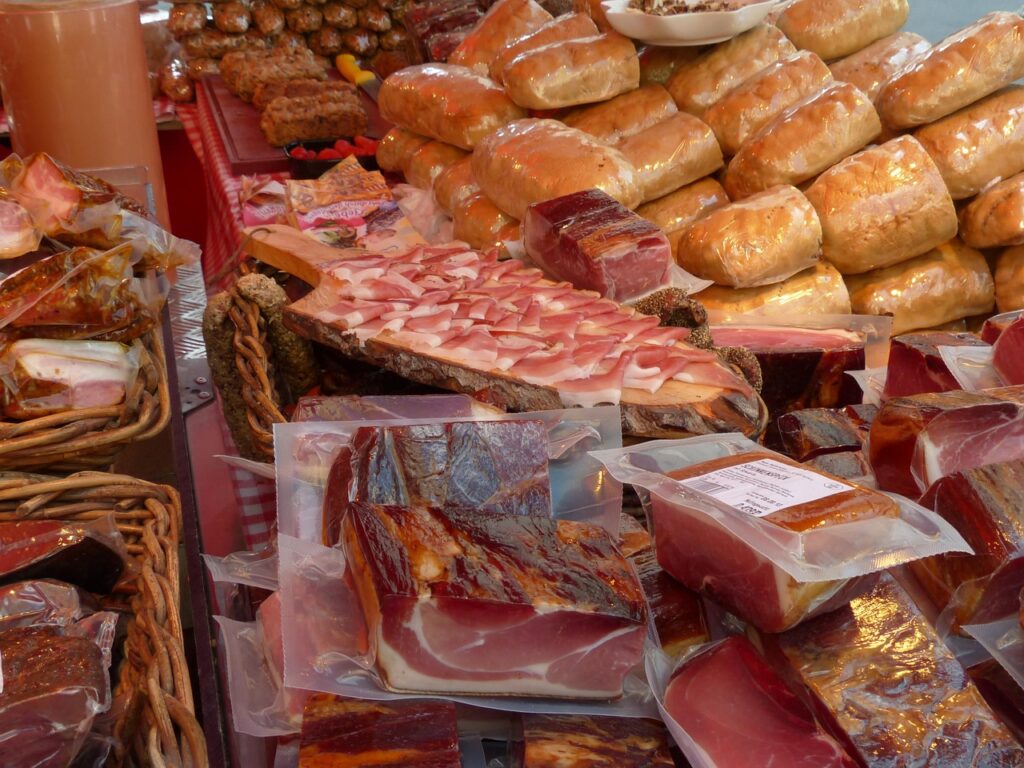
Ham explained
Ham, Blood Sugar Control, etc…
A Taste of History: The Delicious Journey of Ham
Imagine a world without the salty, succulent delight of ham. It’s hard to picture, isn’t it? This versatile meat, born from the leg of a humble pig, has graced tables for centuries, its story woven into the fabric of culinary history.
From the ancient civilizations who first discovered the art of preserving meat through salt to the modern-day kitchens where it sizzles on grills and stars in sandwiches, ham has traversed time and cultures.
Two distinct paths have led to the ham we know and love today: the rustic, rugged path of country ham, and the more refined, urban route of city ham.
Country ham, born from a time when refrigeration was a luxury, relies on the time-honored method of dry curing. Salt, sometimes combined with spices, works its magic, drawing out moisture and preserving the meat for months. This slow, meticulous process results in a ham with an intensely concentrated flavor, a testament to the patience and craftsmanship of generations past.
City ham, on the other hand, embraces a more modern approach, often incorporating sugar and nitrates into the curing process. This results in a ham with a milder flavor, a perfect canvas for experimentation and culinary creativity.
Whether it’s the bold, salty tang of country ham or the delicate sweetness of city ham, there’s a delicious journey waiting to be explored in every slice. So, the next time you savor the smoky aroma of grilled ham or bite into a juicy ham sandwich, take a moment to appreciate the rich history and culinary ingenuity that have brought this delectable meat to your table.
A Taste of History: The Delicious Journey of Ham
TL;DR – Too Long; Didn’t Read
Ham is a popular meat made from the leg of a pig. It’s been enjoyed for centuries and comes in many different styles, from sweet and smoky to salty and savory. Whether you’re grilling it up for a barbecue or adding it to your favorite sandwich, ham is a tasty and versatile food.
A Meat With a Long History
Ham, that delicious meaty goodness, has been around for a long time! Way back when, people figured out that preserving meat by salting it helped keep it from spoiling. This led to the creation of ham, a cured and often smoked part of the pig’s leg. Ham has been a popular food in many cultures for centuries, and it’s still enjoyed around the world today.
How Ham is Made
Making ham starts with the pig’s leg. After the pig is raised and butchered, the leg is carefully prepared. Then, it’s time for the curing process. Curing involves rubbing salt, sugar, and sometimes other spices into the meat. This helps preserve the ham, adds flavor, and gives it a unique texture. After curing, some hams are smoked to give them that delicious smoky taste.
Types of Ham
There are lots of different kinds of ham. Some of the most popular types include:
- Country ham: This type of ham is made by dry curing the meat with salt and sometimes spices. It has a salty and savory flavor and is often served sliced thin.
- City ham: This type of ham is often made by curing the meat with a mixture of salt, sugar, and nitrates. It has a sweeter flavor than country ham and is often cooked before serving.
- Smoked ham: This type of ham is cured and then smoked over hickory or other wood. It has a rich, smoky flavor and is often served sliced or in chunks.
Enjoy Your Ham!
Whether you’re grilling it for a summer barbecue, adding it to a sandwich, or just enjoying it on its own, ham is a delicious and versatile food. So the next time you see a ham at the grocery store, give it a try! You might just discover your new favorite meat.
Summary
Ham is a popular meat that has been enjoyed for centuries. It’s made by curing the pig’s leg with salt, sugar, and sometimes spices. There are many different types of ham, including country ham, city ham, and smoked ham. Each type has its own unique flavor and texture. Ham is a delicious and versatile food that can be enjoyed in many different ways.
More on Ham…
- ## SEO Keywords: Ham & Blood Sugar Control
- General:
- Ham and blood sugar
- Ham and diabetes
- Ham blood sugar impact
- Ham glycemic index
- Ham glycemic load
- Ham and insulin response
- Ham and blood glucose levels
- Ham and sugar control
- Healthy ham options
- Low glycemic ham
- Ham and weight management
- Ham and blood sugar management
- Specific Ham Types:
- Cooked ham blood sugar
- Smoked ham blood sugar
- Honey ham blood sugar
- Ham steak blood sugar
- Prosciutto blood sugar
- Ham and pineapple blood sugar
- Ham and beans blood sugar
- Recipes & Cooking:
- Low blood sugar ham recipes
- Diabetic friendly ham recipes
- Ham recipes for blood sugar control
- Healthy ham breakfast recipes
- Ham dinner recipes for diabetics
- Ham and vegetable dishes for blood sugar management
- Health & Nutrition:
- Ham and blood sugar levels for diabetics
- Ham and blood sugar control for weight loss
- Ham and blood sugar control for athletes
- Ham and blood sugar control for seniors
- Ham and blood sugar control for pregnancy
- Comparison & Alternatives:
- Ham vs turkey blood sugar
- Ham vs chicken blood sugar
- Ham vs beef blood sugar
- Ham vs pork loin blood sugar
- Ham vs bacon blood sugar
- Other:
- Ham blood sugar chart
- Ham blood sugar tracker
- Ham and blood sugar forum
- Ham and blood sugar research
- Ham blood sugar myths
- Ham blood sugar facts
- Ham blood sugar tips
- Ham blood sugar advice
- Ham blood sugar awareness
- Please note:** This list is a starting point and can be expanded upon by considering additional keywords related to specific ham varieties, serving sizes, cooking methods, and individual health conditions.





